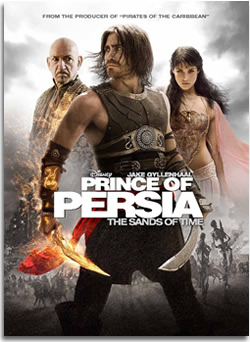 Despite persistent claims of its liberal nature, Hollywood isn’t always known for cultural sensitivity. Whether in its use of ethnic stereotypes or casting choices, one has to wonder how far Hollywood has come since the days of casting Elizabeth Taylor as Cleopatra. Certainly things have changed for Hollywood, though it’s not always apparent while looking at movie posters in one’s local multiplex.
Despite persistent claims of its liberal nature, Hollywood isn’t always known for cultural sensitivity. Whether in its use of ethnic stereotypes or casting choices, one has to wonder how far Hollywood has come since the days of casting Elizabeth Taylor as Cleopatra. Certainly things have changed for Hollywood, though it’s not always apparent while looking at movie posters in one’s local multiplex.
One significant change for Hollywood in the 21st century is the make-up of its viewing audience. Hollywood films span the globe and play in theaters alongside their international equivalents. This increasingly diverse audience is realizing there is no reason why movies they see should not reflect that same diversity and awareness. At times this leads to some controversy; take M. Night Shyamalan’s casting choices for this summer’s THE LAST AIRBENDER, or the reaction spawned by the 2006 movie 300.
Adapted from the graphic novel penned by Frank Miller in 1998, 300 tells a bombastic tale of the battle of Thermopylae in 480 B.C. Told by the lone survivor of the 300 Spartans who faced the armies of Xerxes, it is doubtful this movie was ever intended to be historically accurate. Much to the indignation of modern-day Iranians, the Persian armies were depicted as barely human, resembling the orc hordes that propelled the Lord on the Rings trilogy to such great success a few years prior.
This week Disney will bring its audience to some imaginary middle east with Prince of Persia: The Sands of Time, a film adaptation of the popular 2003 Ubisoft video game. Videogame adaptations have not faired well on the big screen, especially compared to such similar pop-culture fair as comic book or eighties era toy adaptations. In the hands of producer Jerry Bruckheimer, however, Disney is hoping to buck this tendency with successful movie franchise. Bruckheimer succeeded in turning a Disneyland ride into a trilogy of money making movies, with a fourth installment, Pirate of the Caribbean: On Stranger Tides, scheduled for release in 2011. Who would have thought that possible back in 2002?
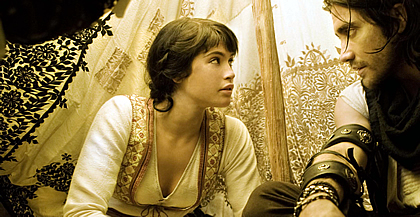
In the lead role of Prince Dastan, the California-born Jake Gyllenhaal sports long hair and a five o’clock shadow. One has to wonder if this is costuming shorthand intended to have him look remotely Persian. If it succeeds, it’s only in comparison to the fair-skinned former Bond girl Gemma Arterton, who seems to be spending the year in sandals and linens. She also played the leading lady opposite Sam Worthington in the comparatively superior Clash of the Titans. For a touch of gravitas, enter Sir Ben Kingsley; the actor who won an Oscar for his portrayal of Gandhi in 1982. He also earned himself a Razzie Award for Worst Supporting Actor in 2007. That movie was BloodRayne and it too was once a videogame.
Persia by Way of Europe
Gemma Arterton is not the only Bond connection to be found in Prince of Persia: The Sands of Time. The second connection between James Bond and the Prince of Persia can be found in the labors of two French athletes; Sébastien Foucan and David Belle. Together they compose the second generation founders of Parkour or l’art du déplacement.
The opening chase between Foucan, as the bomb-maker Mollaka and CASINO ROYALE star Daniel Craig, placed Parkour under a spotlight brighter than any the art had experienced before. Some may have seen David Belle’s Parkour action in Luc Besson’s DISTRICT B13 two years earlier or caught Foucan in the documentary Jump London. But for most American movie-goers CASINO ROYALE’s opening chase scene was their first exposure to the art.
Parkour, or ‘the art of free-running’ as it’s also called, is not quite a martial art. Some call it skating without a skateboard; most would describe it as a method for moving through an urban environment uninhibited by any obstacle. With roots in the French military, its guiding principles stem from Navy officer Georges Hébert’s personal motto "Être fort pour être utile"--"Being strong to be useful." Over the course of two World Wars Hébert developed a training method that emphasized strength, agility, flexibility and bravery.
Come the end the 1950’s a young Raymond Belle distinguished himself as the heir apparent to Hébert’s legacy. Playing a key role amongst Parisian firefighters, he was a member of their very first helicopter-borne unit by 1973, when his son David was born. Raised on the training and theory begun by Hébert a generation prior, David Belle has become the face of Parkour and an obvious choice for consultation in bringing this sort of videogame action to the screen.
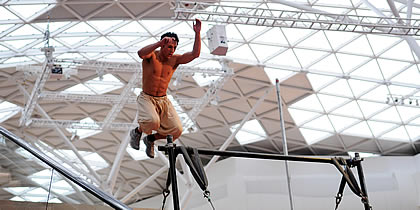
Persia by Way of Hong Kong
Parkour is quickly replacing wire-fu as the hip-not-so-new thing action movies must include. Even in Hong Kong, Donny Yen has incorporated the sensibility to his latest film BODYGUARDS AND ASSASSINS . Oddly, both movies choose an extended chase through the village market district to showcase these stunts. The similarities end there.
Of course anyone who’s watched a Hong Kong import in the past decade may well attribute such stunts to another source entirely. With a career that spans over three decades and about a hundred odd movies, Jackie Chan produced hundreds of Parkour stunts, in spirit and technique, if not name. While David Bell was leaping through his middle school obstacle courses Jackie Chan was filming cutting-edge chases through sprawling Hong Kong malls.
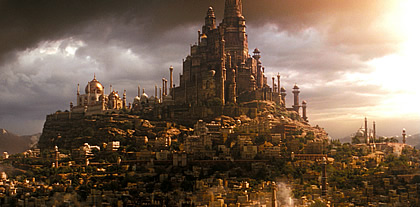
Persia by Way of Disney
Director Mike Newell makes it clear who he intends his audience to be with-in the movie’s opening scene. This time the Parkour-scented chase through the village market features a young boy showing how easy it can be to jump from rooftop to rooftop while his adult pursuers stumble and fall. If it was meant to play for laughs Newell might have considered a close review of some Harold Lloyd footage or at least recycle the story boards from Disney’s 1992 Aladdin.
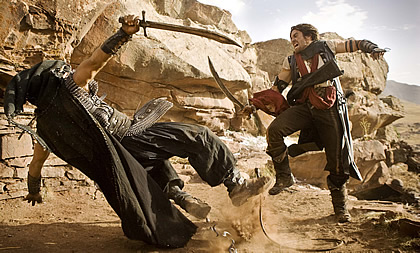
The movie arranges set pieces, puzzles and boss fights with dutiful loyalty to the video game plot. The digitally enhanced fight scenes remain almost entirely bloodless with the standard swashbuckling tropes presented in a collage of familiar images. There is a city under siege, many horses are ridden, shields are battered with swords or axes, arrows fly through the air and there are plenty of ropes to swing from.
As the movie slows down, the dialogue becomes wince inducing in a failed attempt to add some political intrigue. Persian might as well have been replaced with Cimmerian or Persia replaced with Arrakis for all the resemblance the movie has to the history or mythology of the region. As more characters are introduced to the adventure, the movie plays out like a well costumed MMOG.
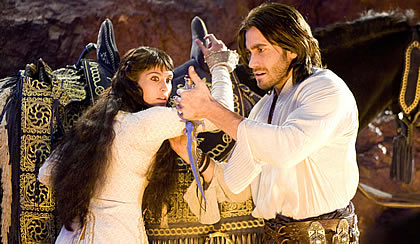
The Freudian symbolism sheathed within the movie’s quest for the Magoffin will likely go unnoticed by the young boys who are this movie’s intended audience. The allegorical weapon of mass destruction, occupation started under false pretenses and political ambitions of a family of brothers all serve to make jumping digital snakes and trained ostriches a welcomed relief. By the end of Prince of Persia: The Sands of Time, some audience members will depart the theater amused and entertained, others will probably exit wishing they could have turned back time far enough to have seen something else entirely.
About
Patrick Lugo :
![]() Patrick Lugo as been a stalwart member of the KungFuMagazine team for well over a decade. Over the years he has produced countless designs and illustrations as well as some writing.
Patrick Lugo as been a stalwart member of the KungFuMagazine team for well over a decade. Over the years he has produced countless designs and illustrations as well as some writing.
![]() Print Friendly Version of This Article
Print Friendly Version of This Article
















